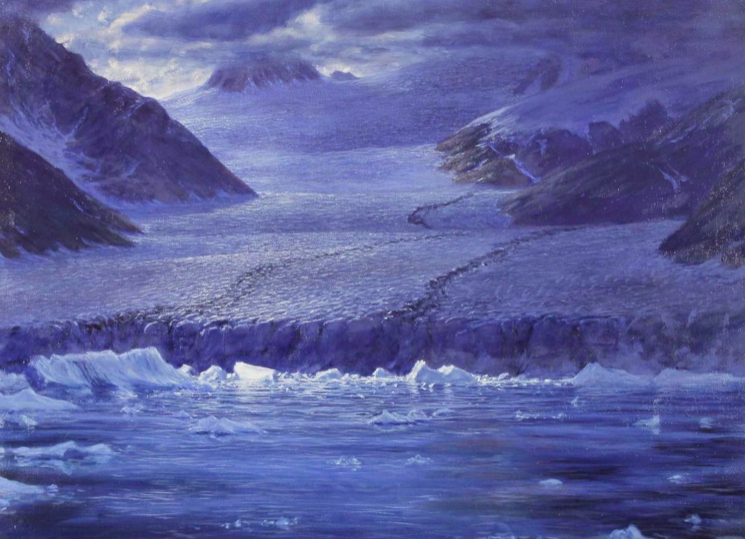
The exhibit titled Painting at the end of the Ice Age, features 67 paintings by Rosenthal’s fine art paintings opened at Anchorage Museum of History and Art which will run through till September, 2025.
David Rosenthal has been painting for over 45 years about the process of global ice age which he feels is still in process of ending.
Painting at the End of the Ice Age

Painting at the End of the Ice Age is a science and art exhibit at Anchorage Museum of History and Art, created by artist David Rosenthal, based on almost fifty years of experience observing retreating glaciers and other changes in the environment associated with global warming.
The exhibit at Anchorage Museum of History and Art uses Rosenthal’s realistic paintings to attract attention to the subject of climate change. Series of paintings showing glaciers changing over time illustrate the dramatic changes seen in the last five decades. Informational narrative, historical and science panels provide context for the paintings and illustrations.
Narrative panels provided by David Rosenthal, science and historical panels provided by scientists and other knowledgeable observers. The exhibit is a unique tool for educating people about global warming in a non controversial way.
Rosenthal states “From my perspective as an artist, I believe the Ice Age is still ending, with vast amounts of ice still locked in mountain glaciers and ice sheets,” in one of his informational pieces that are part of his current exhibit.
“Combined, the glaciers and ice fields in Alaska form one of the largest areas of glaciation in the northern hemisphere, but they are just a remnant of the Cordilleran ice sheet that covered much of northwest North America.”

Rosenthal relies solely on drawings done in field, memory and experience to create his paintings, as narrated by him in the exhibit.
“Photographs may be more accurate, but they are passive recordings of light, gathered from one point in space and from a fraction of a second in time. When I draw a scene, I am actively processing the experience from many points in space and time as my eyes move around, looking into the shadows and then into the light. Colors are adjusted constantly.” he says. “For me, the resulting pieces are more real than photographs”.
To the exhibit at Anchorage Museum of History and Art, he introduces the narrative as “Glaciers surge and retreat rapidly in geological terms, and paintings from my relatively short lifespan show significant changes over time.”
“It might be hundreds, if not thousands, of years before the Ice Age is truly ended, but I feel very lucky to live in this time when I can still experience and paint icy landscapes.”

It’s not just the beauty of the glaciers through his work, but he also tells the story of the retreat of the global ice over the past 45 years.
Rosenthal’s paintings Anchorage Museum are accompanied by the artist’s reflections along with insights from geologists, oceanographers, biologists, and self-taught naturalists.
Blending observation, science and emotion, Painting at the End of the Ice Age is Rosenthal’s visual testament to a changing landscape.
Rosenthal has traveled across Arctic regions, Antarctica Continent, Greenland Ice Cap, Greenland Coast, Norway, New England and the South west of the United States. His exhibit at the Anchorage Museum includes work on ice and glaciers across Alaska, Canada and Antartica.
Before becoming a self taught painter, Rosenthal was originally a physicist and developed an interest in northern latitudes in Antarctica.
David Rosenthal’s Journey
Rosenthal grew up in Maine and graduated from the University of Maine at Farmington in 1976. In 1977, he made his first trip to Cordova, Alaska, to work in the fishing industry. Initially working seasonally, he eventually moved to Cordova full-time in 1981, and he has called it home ever since. Balancing his work as a fisherman, he developed his career as an artist and began teaching drawing and painting at the local community college in 1981—a position he still holds today. In 1984, he also joined the artist-in-the-schools program, completing numerous residencies across Alaska. This program has allowed him to experience some of the state’s most beautiful places, and he hopes to continue contributing for years to come.
Anchorage Museum Time
The Anchorage Museum welcomes visitors from 10 a.m. to 6 p.m., Tuesday through Saturday, and from noon to 6 p.m. on Sundays. For Anchorage’s First Friday events, it also offers extended hours and free admission.
Check out more news Novacadeau for latest news, breaking news, events, viral posts, etc
